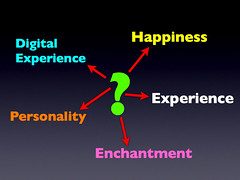 Image by davidking via Flickr
Image by davidking via Flickr
In the past decade, we have undergone a monumental shift in how sellers and buyers engage. The digital revolution has ushered in a new age of how products or services reach people that were unimaginable just a short ten years ago. Advancements in technology and digital media coming in waves causing organizations to be caught unaware of the impact the totality of these waves have had on their businesses. In many ways, buyers and sellers are attempting to engage as if they are in a department store and sellers are on the down escalator and buyers are passing them by on the up escalator. This is most notable in the B2B spectrum of marketplaces.
In 1999, B. Joseph Pine II and James Gilmore published The Experience Economy: Work is Theatre and Every Business is a Stage. A truly groundbreaking book that made a lasting impression upon me around the same time persona development was taking shape. Pine and Gilmore can be characterized as oracles for they offered the premise that we were entering an experience economy where value was created by staging memorable experiences for customers. Many successful B2C entities, such as Disney, leveraged the principle of staging a theme to create memorable experiences. As the digital age takes root into the fabric of our economy, CEO’s today, and most appropriately those in the B2B marketplaces, must begin to think about the new era of the buyer experience economy and how it impacts their organization.
Let’s take a look at some areas where the new buyer experience economy will cause rethinking:
- Buying channels versus selling channels: since the dawning of the industrial and manufacturing age, selling became a downstream endeavor. The mandate being finding channels to push and distribute products or services out to buyers. The digital age has ushered in a new way of thinking. That being, creating channels that are upstream and enabling buyers to find you and engage.
- New media adoption: for some B2B markets, adopting new forms of digital media that enable buyers to engage and find you is proving to be disruptive. I am going to shy away from using the often used term of content marketing for the moment. While quality content is important, the larger strategic question for CEO’s to think about is what new forms of media are relevant to their buyers?
- How to organize: This may be especially tough for companies who have a long and rich tradition of large field sales departments where in some cases today even free doughnuts cannot buy an appointment. The old school of compartmentalizing processes into sales, marketing, and service is in serious need of an extreme makeover. Companies need to discover new ways to organize that allows for exceptional buying experiences and removes barriers.
- Buyer experience design as a core competency: While experience design and the notion of customer experience have been around for a few years, B2B organizations as a whole have not embraced these as necessary core competencies. Yes, there are exceptions and some B2B companies have done well in reinventing themselves. By and large though, these efforts have been coined under the labels of initiative, project, program, and the likes. And we all know what happens to those things called initiatives, projects, and programs after the first year.
- Buying conversation versus selling conversation: Interwoven into the DNA of B2B organizations is the many years of sales training, sales programs, and sales systems that have as its aim to begin a selling conversation with buyers. Tremendous investments have been made in selling methodologies and sales systems all promising the results of improved sales performance and increased revenues. Additionally, marketing structure and purpose has been oriented towards supporting selling conversations. There seems to be a problem however if organizations continue to be wedded to their existing sales processes and marketing support systems. Buyers, in the new buyer experience economy, appear to want entirely different conversations. This is not a dire prediction about the end of sales. Far from it. What is true in a new buyer experience economy is that there needs to be a new understanding and rethinking of exactly what constitutes a conversation with buyers today.
Companies who embrace the notion that the new economic difference maker will be that of the buyer experience will find themselves as the market leaders of a new era. A new era that not only sets a stage and theme for experience but also enables buyers to create buying experiences that are unique to them.




Hi
If you had a gun pointed to your head (sorry for the drastic example) and were asked to share your opinion on the 1-3 best examples you know for the Buyer Persona approach: which would they be?
Looking forward to your opinion!
David